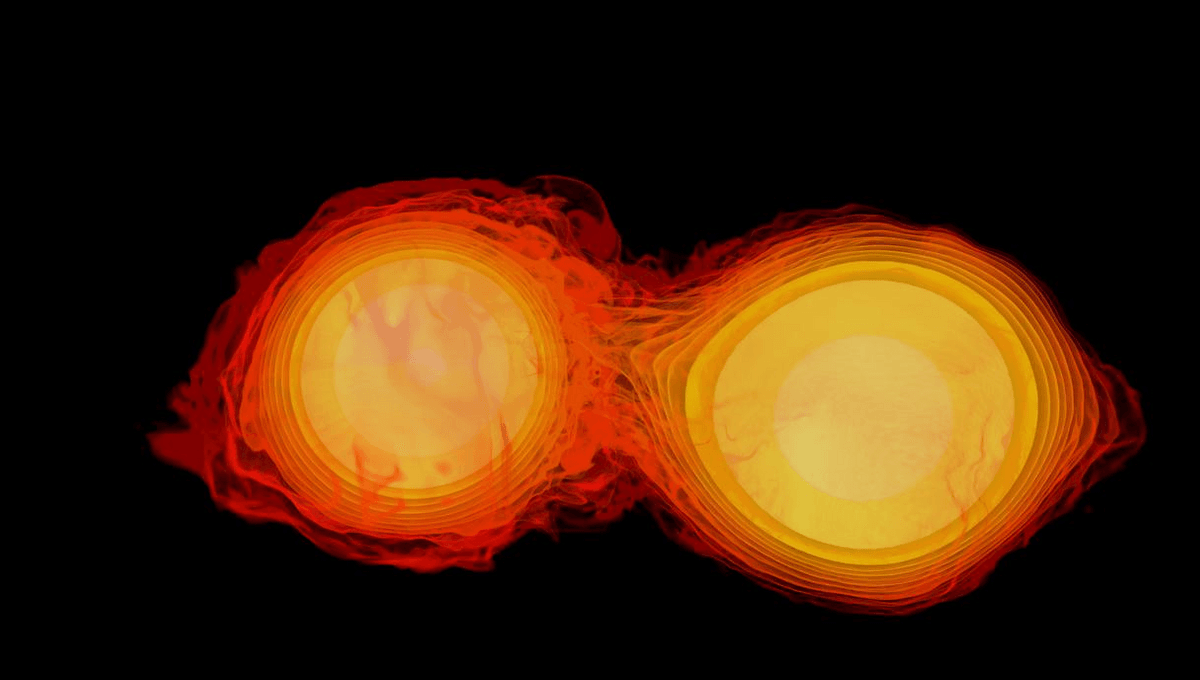
The mergers of binary neutron stars produce elements probably essential for life, but they also pose a threat to nearby inhabited planets. New research attempts to find out just how far away you need to be to enjoy the show while avoiding the damage.
The universe is a hazardous place. We’re now quite familiar with the threat posed by asteroids or comets, but dangers lurk beyond the Solar System as well. Supernovas and other exploding stars are rare, but can be fatal for a large area around. One possible explanation for the Fermi Paradox is simply that most planets get sterilized by radiation bursts before anyone gets technological.
Kilonovas are much rarer than supernovas, but we know much less about them, only having observed our first in 2017. If they pose a threat to much larger areas of galaxies, they could be just as important to the prospects of life sustaining itself. In a yet-to-be peer-reviewed preprint paper, a team of astronomers has made a first effort at working out the threat radius of neutron star mergers.
Although the term kilonova is sometimes used to refer to the entire collision and consequences, it can also just mean the ultraviolet to infrared emissions from radioactive elements thrown off in the explosion. “Binary neutron star mergers (BNS) produce high-energy emissions from several physically different sources, including a gamma-ray burst (GRB) and its afterglow, a kilonova, and, at late times, a remnant many parsecs in size,” the authors write. “Ionizing radiation from these sources can be dangerous for life on Earth-like planets when located too close.”
The unsafe locations for these differ, however. The kilonova spreads in all directions, whereas the GRBs are focused – if you’re located off the axis of the GRB the kilonova is your greatest threat. On the other hand, you can be a long way from the event and still be at risk if you happen to be in the GRB’s cone.
The authors note that previous work has explored the GRB threat, so they focus on the neglected aspect – how much danger there is if you’re off-axis. Surprisingly, they conclude the biggest concern is not the immediate explosion, but cosmic rays thousands of years later.
“For baseline kilonova parameters, we find that the X-ray emission from the afterglow may be lethal out to ∼5 pc (16 light years),” they write, “And the off-axis gamma-ray emission may threaten a range out to ∼4 pc (13 light years), whereas the greatest threat comes years after the explosion, from the cosmic rays accelerated by the kilonova blast, which can be lethal out to distances up to ∼11 pc (36 light years).”
Although the Earth’s atmosphere would initially stop most, if not all, of the radiation, a set of processes would be initiated that would lead to the destruction of the ozone layer, exposing most living things to death by UV radiation. Secondary particles from cosmic rays could cause cancer even underground.
The paper also notes that previous studies have concluded that if you have the misfortune of being close to the axis of a GRB, radiation can be lethal up to 7,000 light-years away for long GRBs. Even bursts lasting less than two seconds are dangerous to 700 light-years away if one is on axis. Not all GRBs are caused by neutron star mergers.
Overall, the authors conclude kilonovas should not be high on the list of things you need to worry about. Recent work has indicated that certain types of supernovas pose a delayed threat to planets at greater distances than the 50-100 light-years usually quoted.
This makes the volume of space threatened by the two events similar, but neutron star mergers are far less common. It’s unlikely one has happened close enough to Earth to be a danger in the planet’s lifetime.
Certainly, there is little immediate risk. The closest known neutron star is at least 250 light-years away. For a kilonova you need the much rarer event of two locked in such a tight orbit they will eventually meet. The danger would have been higher when the Sun was still part of its original cluster, but not by much.
A preprint of the study is available on ArXiv.org.
Source Link: What’s The Risk A Kilonova Will Kill You?